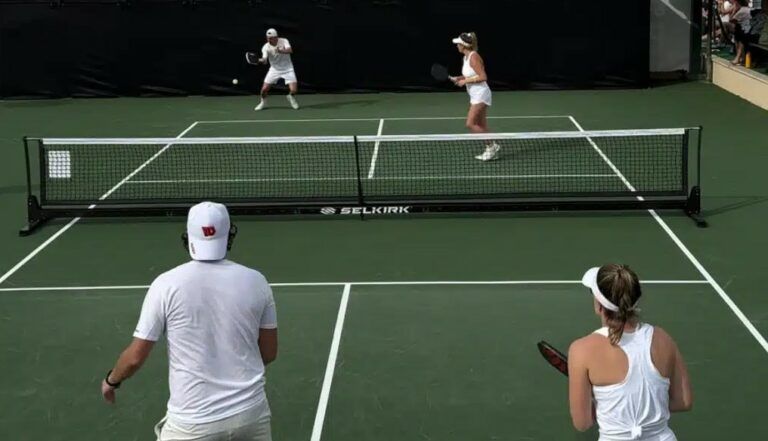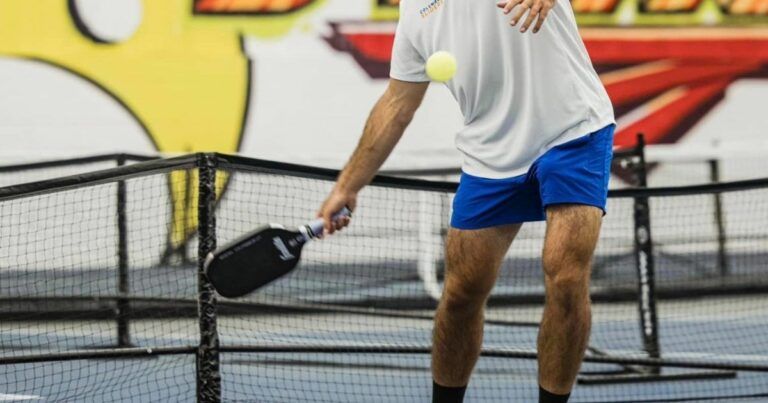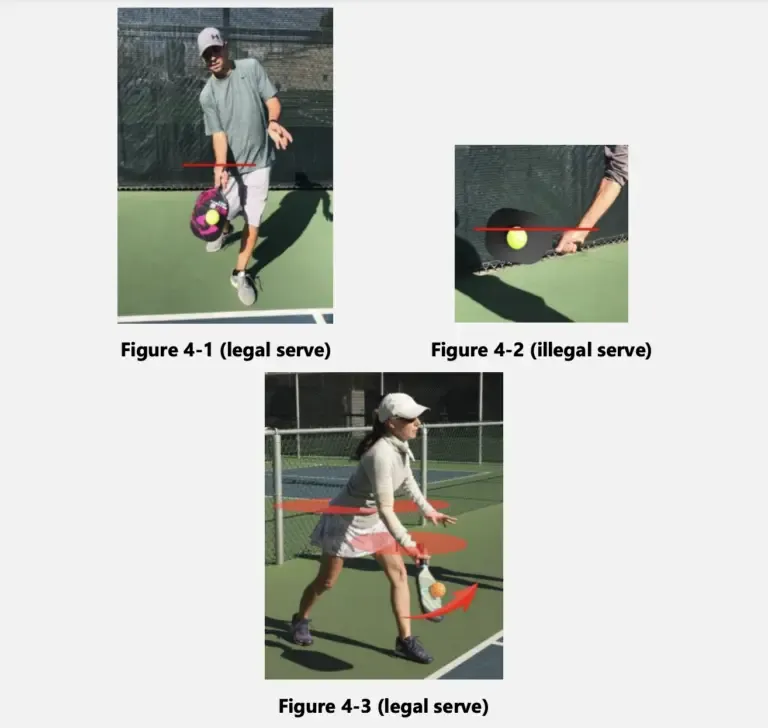Understanding the Basics of Pickleball Serving
Serving is more than just putting the ball in play; it sets the tone for the entire rally. A strong serve can put pressure on opponents, making them react quickly, which could lead to mistakes and point opportunities. Conversely, a poor serve might lead to missed opportunities and lost points. The importance of a legal serve cannot be overstated; it ensures the game remains fair, allowing both sides to play effectively without unnecessary faults or penalties. The beginning of a rally often determines how it unfolds, creating a sense of urgency and excitement.
To fully appreciate serving in pickleball, it’s essential to familiarize yourself with key terms and concepts associated with the sport. Understanding terms like service court, non-volley zone, baseline, fault, let, and rally provides a solid foundation upon which to build your skills. These terms not only define the playing area and rules but also identify common situations you may encounter during matches. Thus, mastering these concepts is paramount for any player.
Key Pickleball Serving Terms
- Service Court: The area where the ball must land during a serve; each side has two.
- Non-Volley Zone (NVZ): Also known as "the kitchen," this is the area close to the net where players cannot hit the ball while airborne.
- Baseline: The back line of the court that marks the boundary for serving.
- Fault: A missed attempt at serving according to the defined rules, resulting in lost service.
- Let: A serve that strikes the net but still lands in the correct service box, resulting in a replay of the serve.
- Rally: The sequence of play that occurs after the serve, involving the exchange of the ball until it goes out of play.

Why is Serving Important in Pickleball?
Serving is crucial in pickleball because it lays the groundwork for a rally. A well-executed serve not only dictates the flow but also puts psychological pressure on your opponent, forcing them to adapt to your playstyle from the outset. When you deliver a serve that is both strategic and precise, you create an immediate advantage, compelling your opponent to scramble into a defensive position. This can lead to mistakes or weak returns, which you can capitalize on in the ensuing rallies.
Moreover, a legal serve is fundamental to maintaining integrity and fairness on the court. Adhering to the rules concerning serving not only keeps the game orderly but also minimizes unnecessary point losses due to errors. By investing time in refining your serve, you instill confidence in your overall game which extends beyond just the initial point.
Types of Legal Pickleball Serves
Pickleball features two principal types of legal serves: the volley serve and the drop serve. Each type has its unique characteristics and offers different strategic advantages, allowing players to choose the one that best complements their playing style. Understanding these serves is essential for maximizing your effectiveness on the court, especially when facing varied opponents with distinct playstyles.

The Volley Serve
The volley serve is executed by striking the ball before it touches the ground, reminiscent of a fastball pitch in baseball. This type of serve can be aggressive and is often used to apply immediate pressure on the opponent. To execute a volley serve, the player must adhere to specific techniques to ensure it remains legal:
- Positioning: Stand behind the baseline with at least one foot on the ground, ensuring proper balance and footing.
- Arm Movement: Your dominant arm must move in an upward arc as you make contact with the ball.
- Paddle Position: At the moment of contact, ensure that the paddle head is below your wrist, specifically below your navel, to comply with legal serving rules.
The advantages of the volley serve include its ability to project more power and precision. For instance, consider how a sniper carefully aims before firing; similar precision during a volley serve can create overwhelming pressure on the opponent.
The Drop Serve
The drop serve, by contrast, allows the ball to bounce before making contact. This method provides an opportunity for a more relaxed stroke and can be an excellent choice for beginners who may struggle with the complexity of a volley serve. Here’s how to properly execute a drop serve:
- Ball Release: Drop the ball from your hand at a natural height with no added spin or force.
- Letting it Bounce: Allow the ball to bounce before making contact.
- Paddle Movement: Strike the ball as it rises to ensure it travels diagonally into the service box.
The drop serve's advantages lie in its simplicity and control. By allowing the ball to bounce, players can establish a rhythm and gauge their strike more naturally, akin to setting a slow-building tempo in music which ultimately crescendos into an impressive performance.
Pickleball Serving Rules: Avoiding Common Faults
Understanding and adhering to the serving rules is vital for avoiding faults. A fault in pickleball can be as disheartening as a missed opportunity; it can derail gameplay momentum and alter the psychological landscape of a match. A clear comprehension of these rules not only secures legality but also builds confidence in your execution.

Rules for a Legal Volley Serve
Executing a legal volley serve requires understanding three critical rules:
- Upward Serving Motion: Your serving arm must move upward at the moment of contact.
- Contact Point Below Waist: You must strike the ball below waist level, specifically below the navel.
- Paddle Position: Ensure the paddle head is below the highest part of your wrist at the moment of contact, maintaining compliance with serving regulations.
Visual aids can significantly enhance understanding. For instance, diagrams showcasing the correct paddle position during a volley serve help demystify the fundamentals for beginners, allowing for more immediate correction of errors.
Rules for a Legal Drop Serve
The drop serve has its own set of governing rules, which include:
- Ball Release: The server must let the ball drop from their hand or paddle face without any added spin or force.
- Ball Bounce: It is mandatory for the ball to bounce once before being hit for a legal serve.
Utilizing videos to demonstrate the appropriate release and bounce can provide clear frameworks for learners, enriching their comprehension and practical execution of the drop serve.
Common Pickleball Serving Faults
Common serving faults that every player should be aware of include:
- Foot Faults: A prevalent error where the server touches or crosses the baseline prematurely, failing to maintain at least one foot behind it.
- Serving Out of Bounds: This happens when the ball lands outside the designated diagonal service court.
- Serving Into the Net: A frustrating occurrence where the serve mistakenly strikes the net.
- Illegal Contact: This includes making contact above the waist during a volley serve.
By recognizing these common faults, players can proactively adjust their techniques to avoid losing points unnecessarily. Regular practice focusing on serving intricacies is crucial for honing your skills and developing a strong serving game.
Pickleball Serving Sequence and Scoring
Understanding the sequence of serving and scoring adds another layer of strategy to pickleball. This knowledge can drastically affect how you approach each point, enhancing your tactical decisions during matches and paving the way for strategic advantages.

Who Serves First?
Determining who serves first can be established through a coin toss or mutual agreement before the game begins. Much like chess, knowing who plays which side can create strategic advantages if you utilize court conditions to your favor, such as wind or sun direction impacting visibility.
Alternating Serves and Side Out Scoring
In both singles and doubles play, players must alternate serves after every point. Understanding that points can only be scored while serving introduces an additional layer of strategy. If your serving game falters and you find yourself in a side-out situation where the opponents gain service you must adapt your game to regain the flow and produce optimal outcomes from subsequent rallies.
Calling the Score Before Serving
To maintain clarity and accountability on the court, it is crucial that the server calls the score before each serve. The accepted format involves stating both team scores, followed by the server's sequence (first or second). This element of the game emphasizes the importance of communication and mindfulness in competitive play, establishing a clear framework for each rally.
Serving Strategies: Placement and Beyond
Once you graspar understanding of the basic serve techniques, your ability to analyze your opponent's weaknesses and adapt your strategy becomes key. Exploring strategic serving options can elevate your game from simply compliant to outstanding.
The Power of a Deep Serve
A strategic deep serve pushes the opponent back, akin to a football quarterback throwing a long pass that forces the receiver to stretch for the ball. By pushing your opponent to the backcourt, you create space at the net, ideally setting up your team’s third-shot drop when you advance. This strategy is instrumental in controlling pace and placement during the match.
Varying Your Serves
Part of serving effectively is the element of surprise. By mixing up your serves switching between volley and drop you can keep your opponent guessing, reminiscent of a magician’s tricks that keep the audience enthralled. A powerful volley serve can catch an opponent flat-footed, while a well-placed drop serve may elicit a weak return, paving the way for aggressive plays.
Targeting Opponent Weaknesses
Observing opponents is crucial for success in pickleball. Notice patterns, such as preferences for specific strokes, and adjust your serving tactics accordingly. For instance, if an opponent has a weaker backhand, strategically targeting that side not only creates opportunities for winning points but also disrupts their rhythm and confidence in returning your serves.
2024 Rule Changes: What's New in Pickleball Serving
Each year brings potential updates to pickleball rules, with the 2024 season introducing notable changes, particularly concerning serving. Staying informed about these shifts is vital for every player aiming to maintain compliance and adapt their techniques accordingly.
Ban on Spin Serves
One of the significant rule changes is the ban on certain types of spin serves, particularly those produced with techniques like the "chainsaw serve." This regulation aims to ensure fairness and prevents players from gaining an undue advantage through manipulative tactics which may not align with the spirit of the game. Understanding what constitutes legal versus illegal spin is crucial for maintaining integrity in competitive play.
Drop Serve Clarifications
Furthermore, clarifications regarding drop serves have been established, emphasizing the importance of natural height during the ball release. Such definitions are designed to prevent misunderstandings that may arise during gameplay and ensure consistency across competitions.
Score-Calling Updates
Updates to score-calling procedures have also been introduced, enabling players to challenge scores and correct errors more effectively. These updates aim to enhance gameplay quality and ensure transparency in competitive environments.
Tips for Beginners: Practicing Your Serve
As a newcomer to pickleball, focusing your practice on serving can yield substantial benefits for overall performance and consistency. Developing a structured approach not only aids in mastering your serve but also strengthens your overall game strategy.
Focus on Consistency Over Power
When starting, prioritize consistent serving rather than sheer power. Just like a painter refining their technique, your aim should be to develop a reliable serve. Over time, the addition of power will come naturally as you gain confidence in your execution.
Develop a Pre-Serve Routine
Creating and adhering to a pre-serve routine can enhance mental focus, helping you feel more prepared and ensuring you approach each serve with the necessary mindfulness. Just as athletes follow specific rituals, having a routine can stabilize mental pressure, fostering a sense of control.
Practice Drills for Accuracy and Placement
Regular practice drills aimed at improving accuracy and placement can dramatically enhance your serving skill. Incorporating targeted practice sessions can sharpen your focus and improve your overall ability to execute strategic serves, reminiscent of an archer honing their aim before an important competition.
Utilizing these strategies will arm you with the knowledge and skills necessary to thrive in the resilient world of pickleball serving. Well-executed serves not only lead to successful rallies but also enhance your overall gameplay experience, ensuring that every match is an opportunity for growth.
Conclusion
Mastering the legal serve in pickleball is an essential part of becoming a skilled player. Understanding the types of serves available, adhering to the rules, applying strategic serve choices, and keeping an eye on recent developments in regulations are all integral elements of success on the court. Emphasizing precision, adaptability, and a solid practice routine will not only enhance your skills but also contribute to the enjoyment of this dynamic sport. So lace up your shoes, pick up your paddle, and let the games begin!










